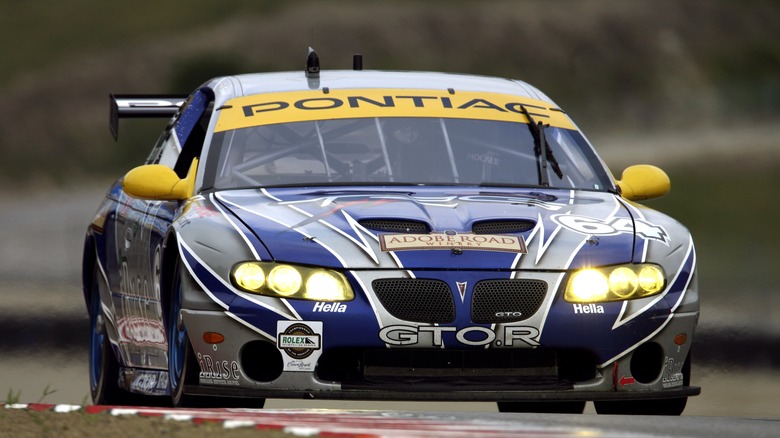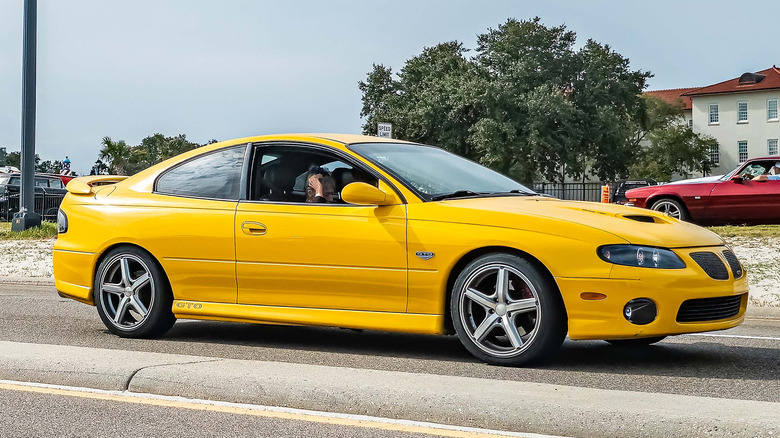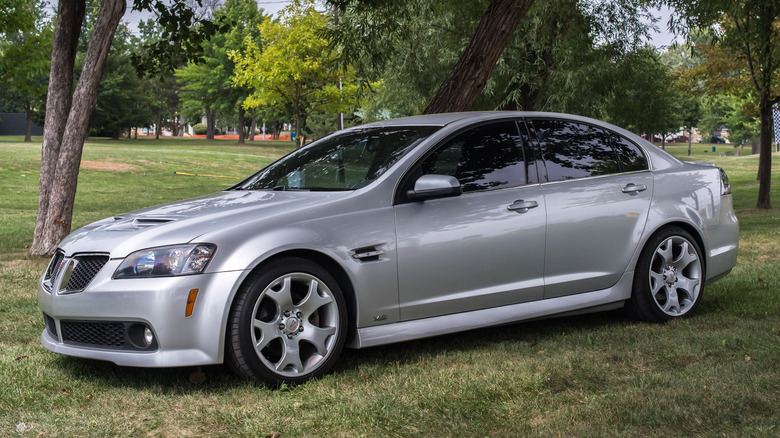Pontiac GTO Vs. G8: What's The Difference Between These Rebadged Holdens?
A few years before the 2009 General Motors bankruptcy eliminated the Pontiac Motor Division, some of the true believers at GM made an attempt to infuse some old-school Pontiac excitement into the brand's lineup. The plan was to take some of the higher-performing vehicles from GM's Australian brand Holden and transplant them into the U.S. market as Pontiacs. This move resulted in the badge-engineered 2004-06 Pontiac GTO coupe and the even-shorter-lived 2008-09 Pontiac G8 sedan.
The story of the 21st century GTO and G8 reflects the struggles that GM was going through as a corporation at that time. But beyond that, these rebadged Holdens were legitimate muscle cars for the new millennium, with a period-appropriate blend of horsepower, handling, and luxury.
What might have been if the GM bankruptcy never happened or if Pontiac survived the culling of the brands? We will never know. GM retired the Holden brand less than a decade later in 2017. Let's take a closer look at the differences between the Pontiac GTO and G8.
The Pontiac GTO just didn't look the part
The fifth-generation Pontiac GTO ran from 2004 to 2006 and was based on the Holden Monaro coupe. GM was looking to bring a performance icon to the Pontiac stable, and the Monaro was earning extremely high praise. The Pontiac Firebird and Chevrolet Camaro were discontinued after 2002, leaving a sporty hole in the company's lineup.
The 2004 GTO came with a 5.7-liter 350-horsepower LS1 V8, a choice of six-speed manual or four-speed automatic transmission, plus very comfy leather seats and a limited-slip diff for a little more than $33,000. Unfortunately, it was penalized in the market for both its non-aggressive styling (it simply didn't look like a classic GTO) and its relatively high price. A direct competitor, the Ford Mustang GT, was a big hit with its retro-inspired looks and a much lower price. 2004 GTO production came in at 15,740 units.
For 2005, the GTO received two prominent hood scoops to raise the appearance of aggression, plus a horsepower boost to 400, thanks to the 6.0-Liter LS2 V8. Upgraded brakes were added as well. Only 11,069 units were produced. The 2006 GTO marked the final model year. No substantial changes were made and final-year production numbers clocked in at 13,948. A total of just over 40,000 fifth-gen GTOs were produced.
Online auction prices for these GTOs over the past year show a range from around $10,000 to $30,000 on average, depending on mileage and condition.
The Pontiac G8 was the brand's last gasp
The 2008-09 Pontiac G8 Sedan was a rebadged Holden Commodore. With the GTO's demise two years earlier, the G8 became Pontiac's rear-drive standard-bearer. It was only produced for two years because the GM bankruptcy and the dissolution of Pontiac both began in 2009.
The 2008 Pontiac G8 came in both base and GT trims. Base G8s had a 3.6-Liter, 276-horsepower V6 with a five-speed automatic transmission. The GT had a 6.2-Liter, 361-horsepower LS2 V8 coupled with a six-speed automatic.
The range-topping GXP trim combined a 6.2-Liter, 415-horsepower LS3 V8 with either a six-speed manual or a six-speed automatic. A Nürburgring-tuned suspension setup and ventilated Brembo brakes were also standard on the GXP. With only 1,829 produced, GXPs are the rarest and most highly valued of all G8 sedans. Recent online auction prices for G8 GXPs have ranged from $20,000 to around $52,000, based on mileage and condition.
The GM bankruptcy spelled the end of Pontiac, along with the Saturn, Saab, and Hummer brands (although Hummer recently resurfaced as a GMC sub-brand). Holdens continued to be imported to the U.S. under the Chevrolet brand. One of these was the 2011-17 Caprice PPV, for police fleets only. A civilian Holden, based on the Commodore VF, also made it here as the rebadged model 2014-17 Chevrolet SS, which had many similarities to the Pontiac G8 that preceded it.


